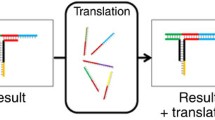Abstract
This paper presents a review of theoretical and practical approaches to the development of the elemental basis of nanoelectronics, i.e., the use of DNA as molecular wires and DNA-based electronic logical cells and nanosensors. A general method for calculating the electron mobility in regular nucleotide sequences is described. The possibility of designing an electronic biochip based on an idea of measurement of the conductance of oligonucleotides is considered. The principle of operation of this nanobiochip is based on the fact that the conductance of a single-chain oligonucleotide changes upon hybridization with a complementary chain. The principle of creation of an XOR logic element (excluded or) based on a two-chain oligonucleotide with control electrodes is determined. It is shown that the appropriate properties are exhibited by DNA duplexes in which electron wave interference that is responsible for the duplex conductance should lead to a logical table corresponding to the XOR element.
Similar content being viewed by others
References
Fink, H.-W. and Schönenberg, C., Electrical Conduction through DNA Molecules, Nature (London), 1999, vol. 398, no. 6726, pp. 407–410.
Kasumov, A.Y., Kociak, M., Gueron, S., Reulet, B., Volkov, V.T., Klinov, D.V., and Bouchiat, H., Proximity Induced Superconductivity in DNA, Science (Washington), 2001, vol. 291, no. 5502, pp. 280–282.
Porath, D., Bezryadin, A., de Vries, S., and Dekker, C., Direct Measurement of Electrical Transport through DNA Molecules, Nature (London), 2000, vol. 403, no. 6770, pp. 635–638.
Kutnjak, Z., Filipic, C., Podgornic, R., Nordenskiold, L., and Korolev, N., Electrical Conduction in Native Deoxyribonucleic Acid: Hole Hopping Transfer Mechanism, Phys. Rev. Lett., 2003, vol. 90, no. 3, pp. 098101-1–098101-4.
Dekker, C. and Ratner, M.A., Electric Properties of DNA, Phys. World, 2001, vol. 14, no. 8, pp. 29–33.
Porath, D., Cuniberti, G., and Di Felice, R., Charge Transport in DNA-Based Devices, Top. Curr. Chem., 2004, vol. 237, pp. 183–227.
Yoo, K.-H., Ha, D.H., Lee, J.-O., Park, J.W., Kim, J.J., Lee, H.-Y., Kawai, T., and Choi, H.Y., Electrical Conduction through Poly (dA)-(dT) and Poly (dG)-Poly (dC) DNA Molecules, Phys. Rev. Lett., 2001, vol. 87, no. 19, pp. 198102-1–198102-4.
Braun, E., Eichen, Y., Sivan, U., and Ben-Yoseph, G., DNA-Templated Assembly and Electrode Attachment of a Conducting Silver Wire, Nature (London), 1998, vol. 391, no. 6669, pp. 775–778.
Lakhno, V.D. and Fialko, N.S., Hole Mobility in a Homogeneous Nucleotide Chain, Pis’ma Zh. Eksp. Teor. Fiz., 2003, vol. 78, no. 5, pp. 786–788 [JETP Lett. (Engl. transl.), 2003, vol. 78, no. 5, pp. 336–338].
Lakhno, V.D. and Fialko, N.S., HSSH-Model of Hole Transfer in DNA, Eur. Phys. J. B, 2005, vol. 43, no. 2, pp. 279–281.
Lakhno, V.D. and Sultanov, V.B., On the Possibility of Electronic DNA Nanobiochips, J. Chem. Theory Comput., 2007, vol. 3, no. 3, pp. 703–705.
Lakhno, V.D., Sultanov, V.B., and Pettitt, B.M., Combined Hopping-Superexchange Model of a Hole Transfer in DNA, Chem. Phys. Lett., 2004, vol. 400, nos. 1–3, pp. 47–53.
Tsend, R.J., Tsai, C., Ma, L., Ouyang, J., Ozkan, C.S., and Yang, Y., Digital Memory Device Based on Tobacco Mosaic Virus Conjugated with Nanoparticles, Nat. Nanotechnol., 2006, vol. 1, no. 1, pp. 72–77.
Lakhno, V.D. and Sultanov, V.B., Electronic Logical Gate XOR on the Basis of DNA, Mat. Biol. Bioinf., 2006, vol. 1, no. 1, pp. 123–126.
Ratner, M. and Ratner, D., Nanotechnology: A Gentle Introduction to the Next Big Idea, Upper Saddle River (NJ, United States): Prentice Hall, 2002. Translated under the title Nanotekhnologiya: prostoe ob’yasnenie ocherednoi genial’noi idei, Moscow: Vil’yams, 2004.
Rakitin, A., Aich, P., Papadopoulos, C., Kobzar, Yu., Vedeneev, A.S., Lee, J.S., and Xu, J.M., Metallic Conduction through Engineered DNA: DNA Nanoelectronic Building Blocks, Phys. Rev. Lett., 2001, vol. 86, no. 16, pp. 3670–3673.
Author information
Authors and Affiliations
Corresponding author
Additional information
Original Russian Text © V.D. Lakhno, 2008, published in Fizika i Khimiya Stekla.
Rights and permissions
About this article
Cite this article
Lakhno, V.D. Nanobioelectronics of DNA: From fundamental problems to applications. Glass Phys Chem 34, 666–670 (2008). https://doi.org/10.1134/S1087659608060035
Published:
Issue Date:
DOI: https://doi.org/10.1134/S1087659608060035




